The Qatar General Electricity and Water Corporation (Kahramaa) utility has revealed Mizuho Bank and the state-owned Japan Bank for International Cooperation (JBIC) have agreed to finance the construction of the 10km² Siraj-1 solar project in Al Kharsaah, west of Doha.
Kahramaa said the Japanese lenders have provided senior loans for the QAR1.7 billion ($467 million) project.
Siraj-1 was secured in a tender in January by a consortium led by French oil giant Total and Japanese conglomerate Marubeni. The partners initially submitted a bid of QAR0.0636/kWh but the final price reached QAR0.0571/kWh ($0.016), based on financial market indices. That bid was for a while the cheapest solar power price in the world, after it undercut the world record of €0.0147/kWh ($0.017) submitted by French developer Akuo Energy for 150 MW of solar capacity in Portugal’s first PV auction.
In April, Chinese developer Jinko Power and French energy company EDF submitted the world's lowest solar bid of AED0.0497/kWh ($0.0135330) for the power to be generated by the 1.5 GW Al Dhafra project in Abu Dabi.
Popular content
The initial, 350 MW phase of Siraj-1 is set to be operational in the second quarter of next year with the total project set to be complete in the first three months of 2022.
The project will be 60%-owned by the Siraj Energy joint venture formed by Kahramaa and Qatar Petroleum with Total and Marubeni holding the balance. The solar park will provide the Qatari utility with electricity under a 25-year power purchase agreement.
This article was amended on 23/07/20 to acknowledge the Al Dhafra solar project has agreed the world’s lowest solar power price to date.
This content is protected by copyright and may not be reused. If you want to cooperate with us and would like to reuse some of our content, please contact: editors@pv-magazine.com.



Good to know of such projects.
It would be nice if some details on technology is also provided, as the efficiency of power generation depends on it.
While the price (cost) matters, technology is equally important for which one can select a higher bid.